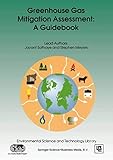Greenhouse gas mitigation assessment : a guidebook [Libro electrónico] / Jayant Sathaye, Stephen Meyers
Por: Jayant Sathaye [autor/a].
Meyers, Stephen [autor/a].
Tipo de material: Libro
en línea Editor: Dordrecht: Springer science, c1995Descripción: xix : diagrs., gráf. ; centímetros.ISBN: 9048146348; 9789048146345; 9789401584661 (Online).Nota de acceso: Disponible para usuarios de ECOSUR con su clave de acceso Nota de bibliografía: Incluye bibliografía Número de sistema: 57309Resumen:
Libro
en línea Editor: Dordrecht: Springer science, c1995Descripción: xix : diagrs., gráf. ; centímetros.ISBN: 9048146348; 9789048146345; 9789401584661 (Online).Nota de acceso: Disponible para usuarios de ECOSUR con su clave de acceso Nota de bibliografía: Incluye bibliografía Número de sistema: 57309Resumen:| Tipo de ítem | Biblioteca actual | Colección | Signatura | Estado | Fecha de vencimiento | Código de barras |
|---|---|---|---|---|---|---|
| Libros | Biblioteca Electrónica Recursos en línea (RE) | Acervo General | Recurso digital | ECO400573095108 |
Incluye bibliografía
Disponible para usuarios de ECOSUR con su clave de acceso
This book describes guidelines prepared by the U.S. Country Studies Program for the evaluation of options to mitigate greenhouse gas emissions. The U.S. Country Studies Program developed these guidelines in collaboration with Lawrence Berkeley National Laboratory to provide developing countries and countries with economies in transition with reference materials for national mitigation assessments. Over 50 countries participating in the program have used the guidelines, which have been refined to reflect their comments. The guidelines delineate a step-wise methodology for evaluating greenhouse gas mitigation options for the energy and non-energy sectors and describe the applications of common analytical tools. The U.S. Country Studies Program uses these guidelines in conjunction with intensive training workshops and follow up technical assistance during the lifetime of each country's study. The program uses similar reference materials to assist counties with their greenhouse gas emission inventories and evaluations of climate change vulnerability and adaptive responses. These guidelines serve three purposes: to assist countries in making decisions about the scope and methodology for mitigation assessments; to provide countries with guidance and step-by-step instructions on each element of a mitigation assessment; and to help countries determine which analytical tools are best suited to their needs and describe procedures for applying these tools. This book describes the application of the most common and readily available methods and analytical tools. Countries are encouraged, where appropriate, to use their own methods." eng
Disponible en línea
Disponible en formato PDF
Subscripción a ELSEVIER 26 de diciembre del 2013
